Positive Health Online
Your Country

The Internal Healing Art of Hsing-I
listed in chi energy martial arts, originally published in issue 34 - November 1998
The internal healing art of Hsing-I is a subject often talked about but is not widely known. Hsing-I is an ancient art of fighting and healing that tunes the mind and body to a finely-honed degree. It is said to have been developed during the period of the Northern Sung dynasty (AD 1127-1276).
General Yueh Fei learned Hsing-I and passed the style onto his troops, giving rise to the saying: ‘It is easier to fight a mountain than to fight the army of General Yueh Fei’. After Yueh Fei, the art was passed on year after year, but did not become well-known. During the Ching dynasty the art was divided into northern and southern branches and now has become increasingly popular throughout the world.
Form-will, body-mind and mind-boxing are all Western translations of Hsing-I. These suggest the interplay of mind and body as the basic principle, but here the essence is missed. The translation should be heart and mind, as it is the heart that controls the emotions and triggers the body’s responses. Combining the heart and body along with the will creates reactions that are more desirable than those earned or acquired without will. As the mind becomes less conscious of them, the techniques become more instinctive. Often, if the heart is fearful, hesitation is the result.
The first and most important point is to learn to relax and breathe properly. Relaxing the body and mind produces movements that are natural and flowing. During regular practice, you should act as if facing a top opponent. However, in a real fight, you should feel emptiness and act like no-one is there. All your action will become natural, and, ultimately, the will moves the body. The road is not a smooth and easy one; only with diligence and an experienced teacher can one make the journey.
Hsing-I is a soft style, wherein how the opponent is received and countered is just as important as striking. The opponent’s force is used against himself, sucking him into the devastation like a swimmer caught in a current. The circle is completed and maximum power is transferred. Because of the inherent danger in this system, to defeat someone is not the most important; it is having respect for life.
Around AD 500, Bodhidharma travelled to China and taught an art which promoted health and long life. Some say the word ‘Hsing-I’ comes from a native dialect and means ‘to cultivate chi.’
Hsing-I, along with paqua and Tai Chi, compose the wu tang systems or internal as opposed to external or Shaolin styles. The twelve animals of Hsing-I are dragon, horse, tiger, eagle-bear, phoenix, snake, swallow, cock, monkey, chicken, tortoise and sparrow hawk, and their spiritual characteristics, along with the five elements (metal, water, wood, fire, earth) comprise the Hsing-I system. It’s an internal system and is therefore most concerned with cultivation of chi. When chi is held in the lower abdomen or dan tien, the body will be harmonious and stable. When chi erupts from the dan tien, power is produced to work the forge of the will. The power is held within until it is used and then regenerated. Every movement contains the theory of yin and yang, or true or not true. Every move must be creative and destructive and combine long and short. It is important not to over-emphasise the hard, explosive aspects of Hsing-I. The study of paqua and Tai Chi will ensure against this.
In a confrontation, you should feel emptiness and act like no-one is there. When attacking, the hand and body should move together, the hands alive and the legs light.
Hsing-I is a true internal style, most concerned with cultivating chi. During practice, the hands and feet should look bent but not bent, straight but not straight. All power and energy are conserved inside until one uses it, yet it will never dissipate when being used. One’s attack or defence follows the heart and mind; the posture should be very gentle, the power should be in harmony with both hard and soft. Every attack or defence must contain the theory of ‘true not true’.
As noted before, Hsing-I was derived from the five elements and the characteristics and movements of animals. The five elements of five styles are as follows:
Elements Styles Actions of chi
Metal Splitting Like the falling of an axe
Water Drilling Like lightening
Wood Crushing Like an arrow
Fire Pounding Like firing a cannon
Earth Crossing Round like a marble
The creative and destructive natures of the five elements work to a common end. The tao of the creative is used in practising, in building body fitness, and in increasing power, strength and energy. The tao of the destructive is used in fighting and self-defence. Put the two natures of the five elements together and they will, if practised hard and learned well, teach you how to change your reaction to an attack, and what to do when facing an opponent.
Alone, neither yin nor yang can form life. One cannot exist without the other. The human body – every limb and bone – can be governed by yin and yang. When the two are harmonised the body and its movements are strong. Without it, strength is scattered and movement confused. Therefore, yin/yang must be understood when practising Hsing-I. There is a relation between Hsing-I and life. Wu hsing means five elements or styles (metal, water, wood, fire and earth).
These elements relate to inner and outer organs:
Metal Water Wood Fire Earth
Inner 5 Lung Kidney Liver Heart Spleen
Outer 5 Nose Ear Eye Tongue Lip
Each element strengthens and restrains the others. Wu hsing strives to bring about the yin and yang refining of your body and is divided into body and movement.
External body: Shoulder Yang
Pelvis Yin
Elbow Yang
Knee Yin
Hand Yang
Foot Yin
External movement: Stretch Yang
Bend Yin
Up Yang
Down Yin
Each of the five elements has a corresponding fighting technique in which each will defeat another. Thus a star configuration is formed.
You can see that metal defeats wood as an axe bites into a tree trunk. Wood will defeat earth as trees grow and cover the earth. Earth will then conquer water as earth absorbs water and subsequently turns water itself into earth. Water will destroy fire because this element can overcome the fiercest conflagration. And finally, fire will overcome metal as the heat of the blacksmith’s forge melts iron. This brings us back to the beginning and this never-ending cycle is the basis of a form called the wu hsing two-man fighting set.
Hsing-I is a powerful fighting style and is a practical means for self-defence. The power is generated from the dan tien which is the centre point of the body’s balance and force. A strike follows a chain of movement beginning with the foot and following through every joint to end at the hand. This creates the theory of the seven stars of Hsing-I. The seven stars are the head, shoulder, elbow, hand, hip, knee and foot, all of which can be used as a weapon singly or in combination. These weapons can attack with fatal power.
Hsing-I is a defensive style where the opponent is allowed the first move and is drawn into the counter attack. This gives birth to the theory of touch-go-kiss and true not true, or to change a technique as the opponent reacts.
A person who practises Hsing-I will undergo certain bodily changes:
1 Three major steps:
a Modify bones
b Modify muscles
c Modify the spinal cord
2 Three ways to practise Hsing-I
a Visible strength
b Invisible strength
c Refined inner strength
These are the principles involved in returning your mind and body to what they were before birth. The Chinese believe that a child’s mind is like a blank tape. After years of problems and troubles the slate must be wiped clean. This is the objective of Hsing-I. It is common knowledge that children heal faster, and are generally fitter and more flexible. Returning to this condition will make you physically and mentally healthy.
Hsing-I relies on soft natural movement. Even though softness is essential to execute the techniques properly, a well-honed body is a necessary requirement. This, Hsing-I movements will strengthen the body inside and out for combat and health. Knowledge of technique is not enough; even the best technician will sometimes be hit.
Kung fu encompasses far more than physical exercise and self-defence. Seldom does anyone realise that a complete kung fu man must treat external as well as internal maladies. The Chinese have four methods of medicine. These are acupressure, acupuncture, moxibustion and herbology.
Acupuncture uses needles to stimulate or divert chi flow from one meridian to another whereas acupressure uses the fingers as needles. Moxibustion and herbology can go together because mox is a herbal preparation like incense that is used to heat up an injured spot and to soak herbal fumes into the skin. Acupressure is the actual hands on massaging and bone setting, which can only be learned from a good teacher and actual practice on available subjects. Massage and bone-setting use point stimulation to loosen a bone in its joint and natural movements to feel the bone back into place. By using knowledge of wu hsing and external body indications of sickness within, a kung fu practitioner can diagnose and treat many maladies with herbs and other techniques.
Each step has a martial arts aspect. One should be wise but ignorant; a wise man keeps everything to himself unless he must defend himself. One practises the martial arts to learn self-defence and maintain good health. This practice is not easily explained in a few words. No matter how it is changed, a style cannot pull away from its origin.
Breathing Application for the Five Elements
By practising the five elements every day, one learns to condition the mind and body and also improve fighting ability. The inner organs of the body will be conditioned because of proper breathing and posture and the chi will strengthen the different organs.
Metal (see Figure 1)
Start in pi chuan stance. Stare at your index finger and breathe slowly from your lower stomach. Inhale and exhale three to five times thinking only of your lungs and filling them with chi. Then continue doing the metal form slowly, breathing on both sides, right and left.
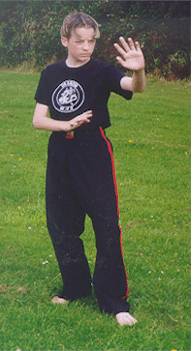
Water (see Figure 2)
Start in pi chuan stance. Make the first move of the water form. Stare at the index finger and concentrate on your kidneys. Inhale and exhale, three to five times slowly, thinking only of filling your kidneys with chi.
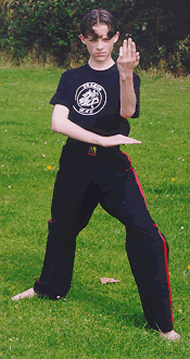
Wood (see Figure 3)
Start in pi chuan stance. Make the first move of the wood form. Stare at the fist and concentrate on your liver. Inhale and exhale slowly, three to five times, thinking only of filling your liver with chi.
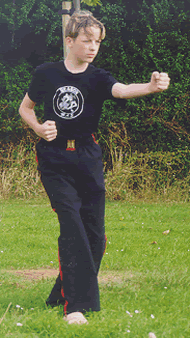
Fire (see Figure 4)
Start in pi chuan stance. Make the first move of the fire form. Stare at the fist and concentrate on your heart. Inhale and exhale slowly, three to five times, thinking only of filling your heart with chi.
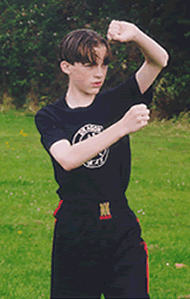
Earth (see Figure 5)
Start in pi chuan stance. Make the first move of the earth form. Stare at the fist and concentrate on your spleen and stomach. Inhale and exhale slowly, three to five times, thinking only of filling the spleen with chi.
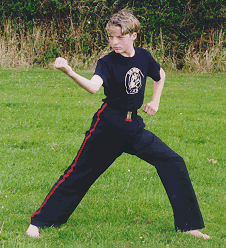
Continue doing each form slowly, over and over again, at least twenty minutes per day for every organ you wish to strengthen. Breathe slowly through your lower abdomen and concentrate on a particular organ. The best time is early in the morning or late in the evening. Do not eat or drink anything one hour before or after doing the exercise. Take a bath or shower before doing these exercises, not afterwards.
Comments:
-
No Article Comments available